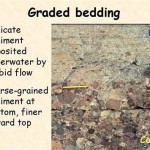Simple Definition of Bedding Plane
The bedding plane is a crucial geological feature that plays a significant role in understanding the formation and structure of sedimentary rocks. It is an essential aspect of sedimentology and helps geologists interpret the depositional environment and reconstruct the geological history of an area. This article explores the essential aspects of the bedding plane, including its definition, characteristics, and significance in geological studies.
### Definition and Formation of Bedding PlaneThe bedding plane is a surface that separates two successive layers of sedimentary rocks. It represents the interface where sediment deposition occurred during the formation of the rock. As sediments accumulate and compact over time, they form distinct layers with different grain sizes, textures, and compositions. The bedding plane marks the boundary between these layers.
### Characteristics of Bedding PlaneBedding planes exhibit several distinct characteristics that help geologists identify and interpret them. These characteristics include:
-Continuity:
Bedding planes extend laterally over significant distances, separating rock layers that may span hundreds of meters. -Parallelism:
Bedding planes are generally parallel to each other, indicating the horizontal deposition of sediments. -Thickness:
The thickness of a bedding plane can vary from millimeters to several meters, depending on the depositional environment and sediment characteristics. -Grain Size and Texture:
The grain size and texture of sediments change across bedding planes, reflecting variations in the energy and depositional conditions. -Fossils and Other Structures:
Bedding planes often contain fossils, sedimentary structures, and other features that provide valuable information about the depositional environment and biological activity. ### Significance of Bedding Plane in Geological StudiesThe bedding plane plays a crucial role in geological investigations and provides valuable insights into the following aspects:
-Depositional Environment:
Bedding planes help geologists infer the conditions under which sediments were deposited. They can indicate whether the deposition occurred in a marine, fluvial, or terrestrial environment. -Stratigraphic Relationships:
Bedding planes establish the stratigraphic order of sedimentary rocks and allow geologists to correlate rock units across different locations. -Structural Geology:
Bedding planes influence the behavior of rocks under stress. They are often associated with faults, folds, and other geological structures. -Economic Geology:
Bedding planes can host valuable mineral deposits and hydrocarbon reservoirs. Understanding their distribution and characteristics is essential for resource exploration and extraction.
Bedding And Lamination Geology Is The Way

Plane Bedding Geology Is The Way

Bed Geology Simple English Wikipedia The Free Encyclopedia

Bed Geology Wikipedia

The Basic Concept Of Geological Map In 2024 Qgeo

Learning Geology Flows Sediments And Bedforms
What Is The Relationship Between Bedding And Foliation Quora
Development Team
What Is The Relationship Between Bedding And Foliation Quora

Definition Of Fu And Dafalias 2024 Tong Et Al For Bedding Scientific Diagram








